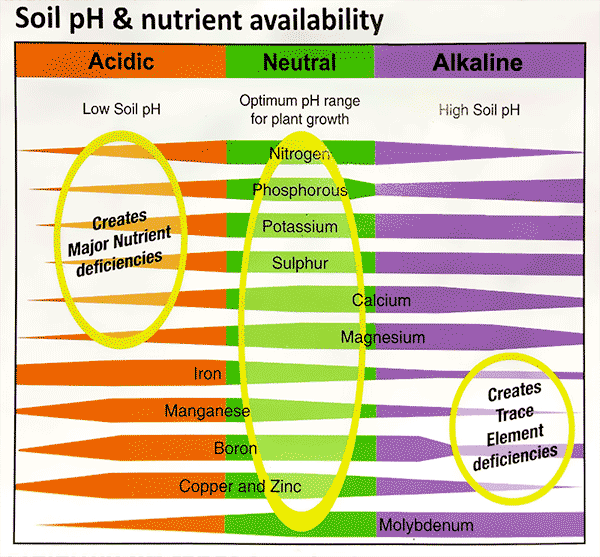
While plants differ from each other in terms of their tolerance for acidity or alkalinity, most plants do best in neutral soil. This is because roots cannot absorb nutrients such as nitrogen, phosphorus and potassium if the soil is too acidic, and they cannot absorb trace elements like iron, manganese and copper if the soil is too alkaline. When a garden bed is being restored, it is important to test the pH of the soil and ascertain whether it needs to be adjusted. Alkaline soils can be made more acidic by using iron sulfate, or in serious cases, elemental sulphur. Acid soils require lime. Always work with an experienced gardener if you are attempting to adjust soil pH.
Soil pH can be measured using a simple kit which includes an indicator that changes colour according to the level of acidity.
Cow manure and compost can sometimes be alkaline. This is because ammonia is generated in the early stages as the manure (or compost) breaks down. In a moist environment, in the absence of oxygen, ammonia creates soil alkalinity. To overcome this, the manure or compost needs to be thoroughly aerated (tossed and turned in air and left to adjust).
At MBCG we currently tend to have slightly alkaline soil, in part because our bulk soil deliveries over the past three years have included some mushroom compost. This compost usually contains lime (calcium carbonate). To adjust our soil back to neutral, we are using coconut coir (which is mildly acidic), iron sulfate in small and measured quantities, and possibly some elemental sulfur.
Our vegetable garden yields up plants (peas, beans, lettuces, tomatoes and so on) which we take away and eat. This means we are removing essential plant nutrients on a regular basis. A key part of our work must be to restore these nutrients to the soil, through adding compost and other fertilisers. In addition to the main nutrients (nitrogen, phosphorus, potassium and calcium) trace elements are also needed. These are supplied through applying a careful sprinkling of rock dust.
395 thoughts on “Acidity and alkalinity of soils”
Comments are closed.